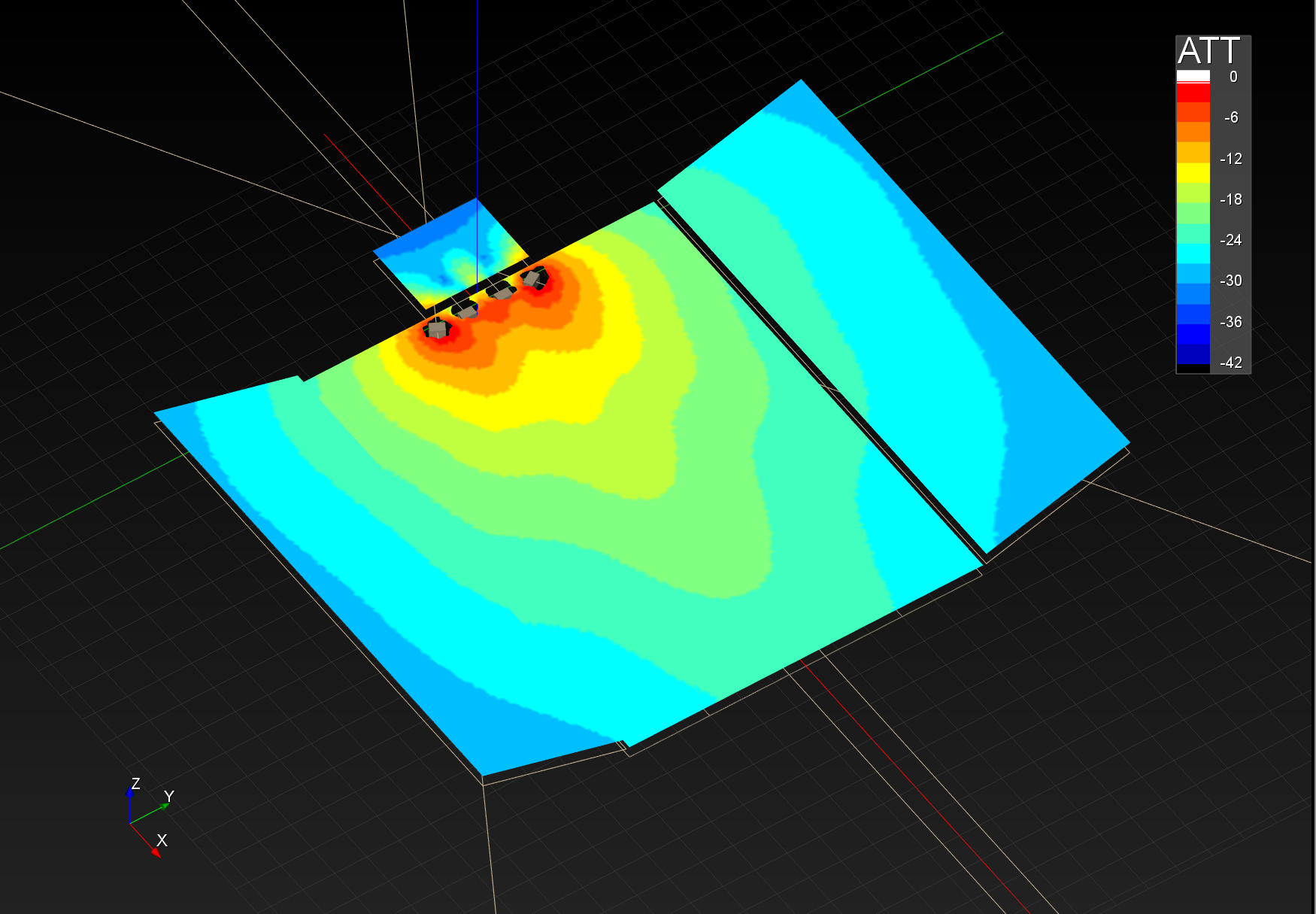Crossroads Array
An unexpected side effect of deploying novel subwoofer arrays in the field is having to come up with something to call it if it works well enough that you want to use it again.
What I have christened the Crossroads array owes its name to a festival at which I recently deployed it. The festival offered a unique combination of design parameters:
Held in an indoor arena (flat floor with raked seating area on the sides). The primary directive was to cover the dancefloor lying in the center of the space, but anyone who wanders up into the raked side seating areas for a break should still be able to enjoy the performances.
Twin stages, facing each other, separated by about 180 feet, with the dancefloor located halfway between the two stages.
Mix position located halfway between the two stages, off center to both (approximately on-axis with one side of the PA). Thus, the system response at this location should be representative of most of the listening area. A slight (~3 dB) LF increase on the dancefloor may be desirable.
A large quantity of acoustic instruments on stage, so rear rejection is paramount.
Our subwoofers cannot be flown for this event, so everything will stay on the ground. We have eight double-18 elements per stage at our disposal. They come off the truck in carts of 2. Applying some basic design theory says our line should be relatively short, since longer lines create narrower horizontal dispersion, which is not what we want here. Instead, we want a wide coverage pattern that extends well beyond the sides of the stage and spills up into the side raked seating. I decided to start by placing the sub carts evenly spaced across the front of the 32’ stage width.
Since we are not pressed for real estate in front of the stage, the outer carts are physically toed out a bit to widen the coverage, and can be electronically delayed to further widen the coverage pattern to taste.
Since keeping the sub energy off the stage is important, we want each cart of two subwoofers to be deployed as a gradient (cardioid) array.
FIGURE 1
In a two-element gradient array, the vector between the acoustic centers of the two sources causes a vertical steering effect. With the bottom subwoofer rear-facing and the top subwoofer forward facing, the resulting energy will be steered upwards in the vertical plane, while the cancellation is steered downwards.
This is borne out in the prediction (63 Hz).
FIGURE 2
Reversing the orientation of the cart, such that the top box is rear-facing and the bottom box is front-facing would create the opposite effect (downward steering of the front lobe, and upward steering of the rear cancellation).
Let’s take a look at how these two orientations perform when half-space loaded: sitting on a floor, instead of floating in theoretical free space (FIGURE 3).
FIGURE 3: Front-Back orientation vs Back-Front orientation when placed on floor (side view, 63 Hz)
The tradeoff here is that the Front-Back (FB) orientation gives better forward-going efficiency and will better “throw” sub energy forward into the listening area, while the Back-Front (BF) orientation does about 6 dB better at placing a cancellation on an elevated stage behind the array.
We can “custom tailor” the behavior in the vertical plane by changing the orientation of each sub stack, and if we don’t like it once it’s deployed, it’s easy to bail out – simply disconnect the cables, rotate the entire stack 180 degrees (they’re on wheels!) and connect the cables again.
Given the specific design goals for this event, I chose a hybrid of the two orientations: the outer pair of subwoofer would have the rear facing box on the bottom, so the energy vector would be tipped upwards in the vertical plane, to better cover up into the raked seating incline along the sides of the room. The inner pair of subwoofers has the reverse orientation – the rear-facing box being on the top of the stack steers the cancellation vector directly towards the artists (and acoustic instruments) on stage.
The final ingredient is about 3 ms of delay on the outer carts, which has the simultaneous benefits of lessening power alley and tightening the impulse response of the array at the off-center mix position. The resulting coverage was exactly what I hoped for, with consistent coverage throughout the listening area, a very slight (about 3 dB) buildup on the dance floor, smooth coverage up into the inclined seats on the sides of the room, and an impressive amount of rear rejection on stage. In fact, the subwoofer energy directly behind the array was about comparable to the energy coming from the other stage, 180 feet away. Scroll down for a 3D prediction and a photo of the deployment.
FIGURE 4 - 3D prediction of Crossroads array as deployed
FIGURE 5 - Photo of deployment





